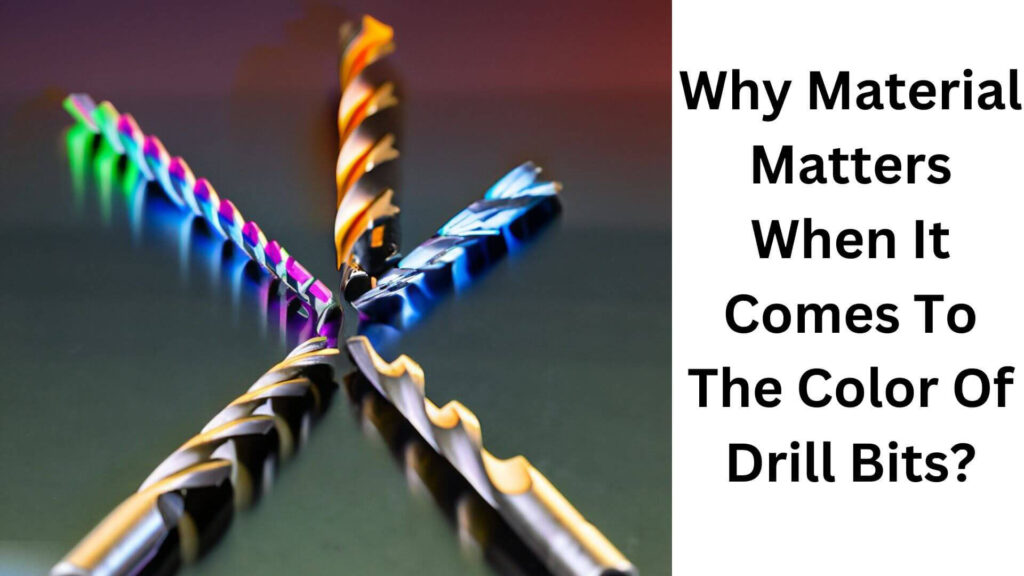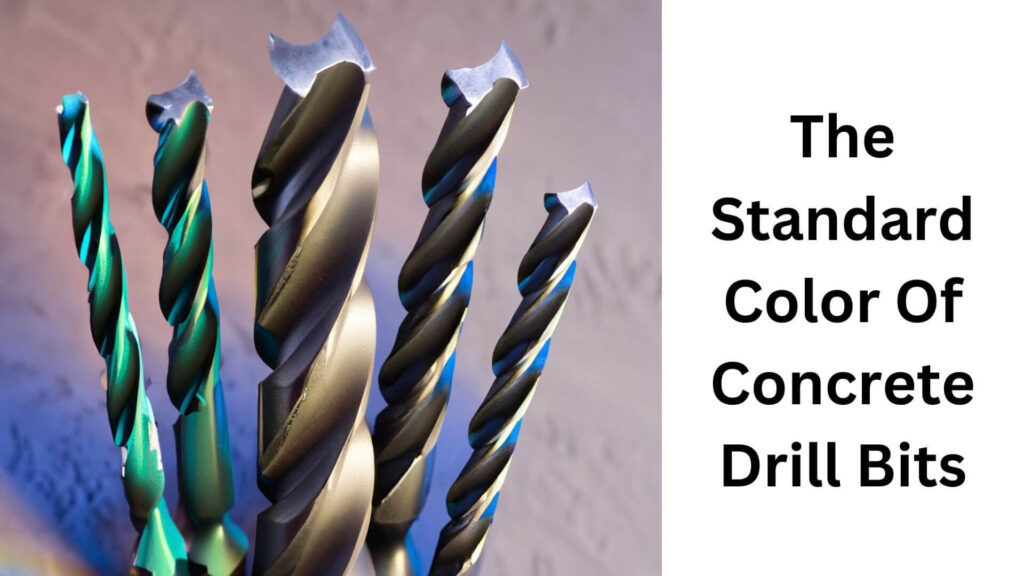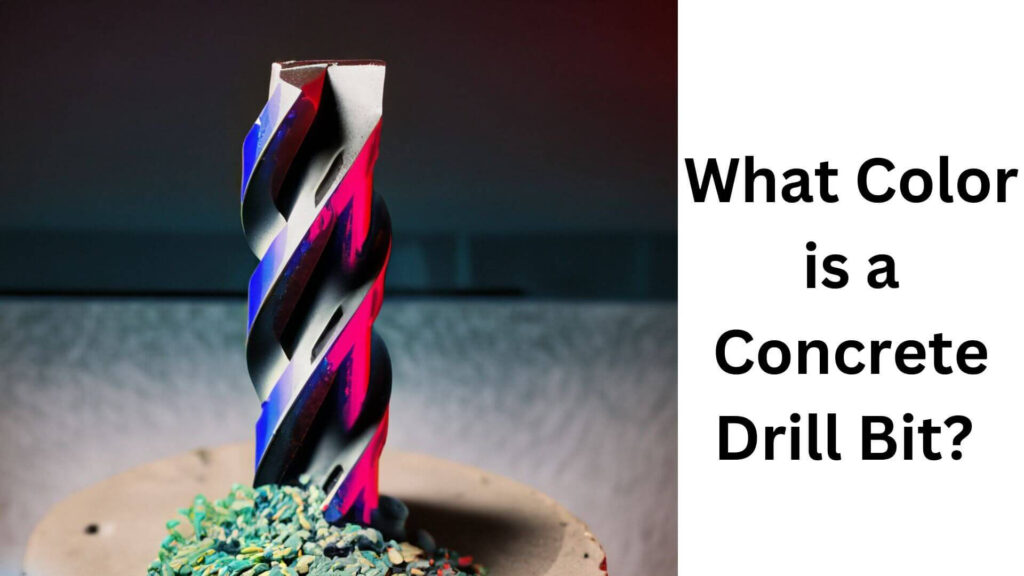If you’ve ever found yourself staring at a concrete drill bit with confusion, wondering what color it should be, you’re not alone.
The answer may surprise you – no “correct” color for a concrete drill bit exists. These indispensable tools come in various hues, from silver and gold to black and blue.
But why does the color of a drill bit matter, and how can you ensure you’re using the right one for the job?
In this article, I’ll explore the colorful world of concrete drill bits and help you choose the perfect one for your needs. So, let’s dive in!
Table of Contents
Understanding Drill Bits
Concrete drill bits are essential for anyone working on construction or DIY projects. They come in various types and sizes, with different materials and coatings that give them other properties and characteristics.
One of the most curious aspects of concrete drill bits is their colors, which vary depending on their materials.
If you have ever wondered about the color of a concrete drill bit, this post will help you discover the surprising answer.
Explain The Basics Of Drill Bits, Their Types, And Materials
Before you dive into the color of concrete drill bits, let’s first review some basic concepts about drill bits. First, drill bits are cutting tools used to create cylindrical holes in various materials, such as wood, metal, plastics, and concrete.
They consist of a shank, which fits into the chuck of a drill, and a spiral-fluted tip, which removes material as it rotates.
Many drill bits are designed for specific purposes, such as drilling through soft or tricky materials, making large or small holes, or creating flat-bottomed or angled holes.
Some common types of drill bits include twist drills, spade drills, step drills, hole saws, and masonry bits.
Drill bits can be made from high-speed steel (hss), cobalt steel, carbide, or diamond.
The choice of material depends on factors such as the type of material being drilled, the speed of the drill, and the desired precision and durability of the bit.
Different materials also have different colors, which we will explore next.
Why Material Matters When It Comes To The Color Of Drill Bits?

The color of a drill bit can give you clues about its material and properties. Here are some examples:
- Silver or gray: This is the color of uncoated hss or cobalt steel bits, standard in general-purpose drilling. They are inexpensive and can drill through many materials but may dull quickly or overheat tough materials.
- Gold or bronze: This is the color of titanium-coated hss or cobalt steel bits, which are more complex and durable than uncoated bits. The coating helps reduce friction and heat buildup, extending the bit’s life and improving accuracy.
- Black: This is the color of black oxide-coated hss or cobalt steel bits, which have a rust-resistant finish that can also help reduce friction and heat. In addition, black oxide bits are commonly used for drilling metal and are less prone to slipping or walking.
- Blue or green: This is the color of carbide-tipped masonry bits with a tungsten carbide tip welded or brazed onto a steel body.
Carbide is extremely hard and can withstand high temperatures and abrasion, making it ideal for drilling into concrete, brick, or stone. The color comes from the brazing material used to attach the tip to the body.
Read More: Extending the Lifespan of Concrete Drill Bits: Tips and Guidelines
Emphasize The Importance Of Understanding The Composition Of Drill Bits To Determine Their Color
The color of a drill bit may seem like a minor detail, but it can have significant implications for its performance and longevity.
Knowing the materials and coatings used for drill bits can help you choose the right bit for your project and avoid damaging your tools or materials.
Some tips to keep in mind include:
- Match the bit material to the material being drilled: For example, use a carbide-tipped bit for concrete, a cobalt steel bit for stainless steel, or a high-speed steel bit for wood.
- Consider the bit size and geometry: Different bits may require different speeds, feeds, or cutting fluids to work well. Consult the manufacturer’s recommendations or a drilling handbook for guidance.
- Check the bit condition regularly: Look for signs of wear, such as dull edges, chipped tips, or bent shanks. Replace worn or damaged bits before they become hazardous or ineffective.
The color of a concrete drill bit can reveal necessary information about its composition and performance. By understanding the basics of drill bits and their materials, you can select the right bit for the job, improve your drilling accuracy and speed, and prolong the life of your tools.
Read More: Concrete Drill Bit Maintenance: Sharpening Considerations and Alternatives
The Standard Color Of Concrete Drill Bits

Concrete or masonry bits are necessary when drilling into harsh surfaces like concrete, brick, or stone.
However, have you ever stopped and considered what color a concrete drill bit is? If you’re like most people, you might assume it’s silver or gray, but that isn’t always true.
Keep reading to discover the surprising truth about the standard color of concrete drill bits.
1. Discuss The Common Belief That Concrete Drill Bits Are Always Silver Or Gray
It’s a common misconception that all concrete drill bits are silver or gray, much like most metal tools. This idea could be because silver is associated with strength and durability, traits that a drill bit should have when drilling through hard surfaces.
However, it’s essential to note that the color of a drill bit is more about its coating than its strength.
2. Address The Reasons For This Assumption, Such As The Association Of Silver With Strength And Durability
As mentioned before, the common belief that drill bits are silver or gray has to do with associating these colors with strength and durability.
Silver is also a corrosion-resistant metal, which is essential when working with concrete or stone, as these materials can cause rapid wear and tear on a tool’s coating.
However, coatings like titanium nitride can also offer the same properties, which could result in different colors for drill bits.
3. Include Expert Opinions And Quotes To Support The Standard Color Theory
According to industry experts, the standard color of a drill bit coating is usually black, gold, or copper.
These colors indicate specific coatings that offer unique properties for drilling into concrete or other hard surfaces. Here are some reasons for these coating colors:
- Black: A black coating is usually made of oxide, and it works best for drilling into hard and abrasive materials like concrete and stone.
- Gold: A gold-colored coating is often used for drilling into more complicated materials like stone or granite. It offers low friction, high wear resistance, and excellent lubricity.
- Copper: A copper-colored coating is best for drilling into softer materials, as it has a greater heat dissipation capacity than other coatings.
The color of a concrete drill bit may not always be silver or gray, but it depends on its coating type. With coatings like titanium nitride, drill bits come in various colors, offering unique properties for specific drilling tasks.
However, choosing a high-quality bit with the correct color coating for the specific task at hand is essential for the best results.
The Surprising Truth About The Color Of Concrete Drill Bits
Have you ever wondered about the color of a concrete drill bit and why they come in different shades? Well, you’re not alone in this quest for an answer. Although some people assume that the color of a concrete drill bit relates to its purpose or special features, the reality is different.
Here I will reveal the surprising truth about the color of most concrete drill bits, explore why they can sometimes be coated with silver or other colors, and briefly discuss factors affecting their color.
Reveal The Actual Color Of Most Concrete Drill Bits
Most concrete drill bits are black oxide, a dark grey or black color that protects them from corrosion. The coating, which typically contains iron oxide, makes these drill bits ideal for drilling into hard materials like concrete and masonry.
While this coating seems like a side effect, it is an essential attribute that provides durability and longevity to the drill bit’s lifespan.
In addition to the black oxide coating, these drill bits can be polished to a mirror-like finish, giving them a silver color that adds aesthetics. However, the color does not affect the performance of the drill bit.
Discuss The Reasons Why Concrete Drill Bits Are Sometimes Coated With Silver Or Other Colors
Although black oxide-coated drill bits perform well and resist rusting, some manufacturers coat their bits with silver to give them a shiny appearance. The silver coating is either titanium nitride or titanium carbonitride, providing a few advantages over the typical black coating.
These advantages include higher visibility, increased cutting speeds, and less friction. Moreover, the shiny exterior makes them less corrosion-resistant, offering longevity to the drill bit.
Highlight The Factors That Affect The Color Of Concrete Drill Bits, Including The Various Materials They Are Made Of
The color of a concrete drill bit primarily depends on the material used for its coating. While black oxide is the most common coating, manufacturers can use different finishes, leading to drill bits in various colors.
For instance, some bits are coated with bronze, giving them a brownish hue. Others could utilize a gold-colored titanium nitride, which offers a stylish finish while protecting them from corrosion.
The materials that make up a concrete drill bit determine its color. Materials that are hard and resistant to wear and tear are ideal for constructing drill bits.
For example, drill bits made up of carbon steel have a black finish, while cobalt can have either a gold or, at times, blue color.
The color of a concrete drill bit depends on the material used to coat it, with black oxide being the most common coating.
While some are coated with silver or other colors, the reason for that is mainly cosmetic or to add functionality. Nevertheless, the durability and strength of these bits are the most critical factors.
The Impact Of Drill Bit Color On Performance
Concrete drill bits are indispensable when drilling into harsh surfaces such as concrete, brick, and stone. Do you ever wonder what color is a substantial drill bit or if it affects the tool’s performance?
The answer may surprise you! Here will explore the impact of drill bit color on performance and discuss the relevancy of drill bit color for different applications.
1. Discuss The Relevancy Of Drill Bit Color On Its Performance
While the drill bit’s color may seem trivial, it can significantly affect the tool’s performance. For example, the color of the drill bit coating indicates the material used.
For example, a black oxide coating is made from black oxide, while a titanium nitride coating is made from titanium nitride.
The suitable coating material can make a massive difference in the performance of the drill bit.
2. Explain How Color Affects Aspects Such As Heat Buildup And Wear Resistance Of Drill Bits
Different colored coatings offer additional benefits. For example, a black or bronze coating improves the heat resistance of the drill bit. This means that the drill bit can drill for extended periods before heating up, significantly improving its durability.
It also decreases the likelihood of warping or bending when exposed to high temperatures. On the other hand, a gold, copper, or titanium coating offers improved wear resistance, which can make a drill bit last longer and retain its sharpness for a more extended period.
3. Include the Pros And Cons Of Drill Bits Of Different Colors For Specific Applications
Here’s a rundown of the pros and cons of drill bits of different colors based on various applications:
- Black oxide: Ideal for drilling into soft materials. These bits offer increased heat resistance, making them suitable for high-temperature applications. However, they can rust over time.
- Bronze oxide: These bits have excellent wear resistance, which makes them perfect for drilling into hard metals. However, they tend to be less heat resistant than black oxide bits.
- Titanium nitride: These bits are highly wear-resistant and excellent for prolonged drilling sessions. Titanium nitride bits’ durability ensures they retain their sharpness even after heavy use. However, they tend to overheat quickly if used at high speeds.
- Cobalt: These bits have a high melting point and work well on tough, hard metals. However, the cons include higher prices and decreased flexibility.
4. Mention The Impact Of Drill Bit Color On Price And Durability
The color of the drill bit can impact its price and durability. For example, black oxide bits are less expensive and long-lasting than other coatings. Bronze oxide bits are more expensive than black oxide bits but are more wear-resistant.
Similarly, titanium nitride bits are often the priciest, but their high wear resistance makes them last longer.
The color of a drill bit coating significantly impacts the tool’s performance. Depending on the application, select the correct colored drill bit to improve your drilling and get the best value for your money. Keep our insights in mind, and you’ll have better luck with your next drilling project.
Frequently Asked Questions On What Color Is A Concrete Drill Bit
What Size Options Are Available For Concrete Drill Bits?
Concrete drill bits are available in various sizes, from 1/8 inch to 1 inch or even more significant.
Are All Concrete Drill Bits The Same Color?
No, not all concrete drill bits are the same color. Some come in silver, black, gold, or bronze.
Can A Colored Concrete Drill Bit Affect The Drilling Process?
No, the color of the concrete drill bit does not impact the drilling process or performance.
What Is The Best Material For A Concrete Drill Bit?
Carbide-tipped or diamond-tipped concrete drill bits are considered the best materials for durability and strength.
How Do I Know Which Size Concrete Drill Bit To Use?
The size of the concrete drill bit you need will depend on the hole size you want to create. Be sure to measure the width and depth of the hole before selecting a drill bit.
Final Thoughts
In sum, the color of a concrete drill bit is not solely for aesthetic purposes but serves a practical function in the drilling process.
The color codes help users identify which drill bit best suits the material they will be drilling into.
Choosing the right color-coded concrete drill bit is essential to prevent accidents, increase efficiency, and ensure the project’s success.
Knowing the right drill bit color can also save time, effort, and money in the long run. As a responsible diy enthusiast or professional contractor, learning about these color codes is an advantage that can set you apart from others.
Drill bit color coding is a critical aspect of construction and should be given the attention it deserves. Remember that safety should always be the top priority; thus, always select the appropriate drill bit color for your project.

Hey, I am Shihab Uddin, I’m a huge fan of DIY crafts. My workshop is where I spend most of my spare time, and I’m always working on some project. To that end, I’d like to share some of my knowledge and experience with you in power tools, woodworking, and other specialized materials fabrication.
I will guide you with genuine knowledge that can assist you with deciding whether a drill is appropriate according to your requirements or not. If you want to find the best drill and know which type of drill is most suited for your needs, then I can guide you with my expertise. My passion lies in helping others find the correct products they need at an affordable price.


